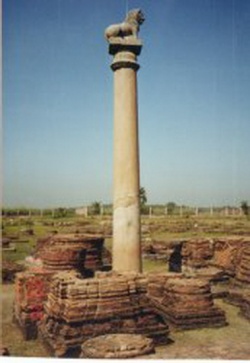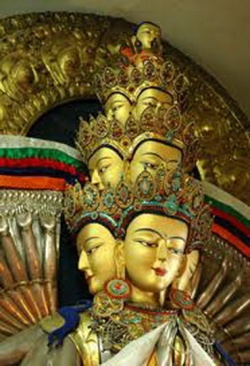Vesāli
Vesāli was the capital of the tribal republic of Vajji and the scene of many important events in The Buddha’s Life. The Buddha had a special affection for the city and when, during his final journey he left it for the last time, he turned around to have one last lingering look at it (D.II,1220) The second Buddhist Council was held there about a hundred years after The Buddha’s passing. Today, the ruins of Vesāli are spread over a wide area and the most important of these are a huge stone pillar with a lion capital, a large stūpa next to it and another stūpa nearby Thought by archaeologists to be the very one erected over the Vajjian’s one-eighth share of The Buddha’s ashes. Vesāli is 40 kilometres north of Patna, the capital of the modern Indian state of Bihar.
A city, capital of the Licchavis. The Buddha first visited it in the fifth year after the Enlightenment, and spent the vassa there (BuA., p. 3). The Commentaries give detailed descriptions of the circumstances of this visit. KhpA.160ff.= SnA.i.278; DhA.iii.436ff.; cp. Mtu.i.253ff
Vesāli was inhabited by seven thousand and seven rājās, each of whom had large retinues, many palaces and pleasure parks. There came a shortage in the food supply owing to drought, and people died in large numbers. The smell of decaying bodies attracted evil spirits, and many inhabitants were attacked by intestinal disease. The people complained to the ruling prince, and he convoked a general assembly, where it was decided, after much discussion, to invite the Buddha to their city. As the Buddha was then at Veluvana in Rājagaha, the Licchavi Mahāli, friend of Bimbisāra and son of the chaplain of Vesāli, was sent to Bimbisāra with a request that he should persuade the Buddha to go to Vesāli. Bimbisāra referred him to the Buddha himself, who, after listening to Mahāli's story, agreed to go. The Buddha started on the journey with five hundred monks. Bimbisāra decorated the route from Rājagaha to the Ganges, a distance of five leagues, and provided all comforts on the way. He accompanied the Buddha, and the Ganges was reached in five days. Boats, decked with great splendour, were ready for the Buddha and his monks, and we are told that Bimbisāra followed the Buddha into the water up to his neck. The Buddha was received on the opposite bank by the Licchavis, with even greater honour than Bimbisāra had shown him. As soon as the Buddha set foot in the Vajjian territory, there was a thunderstorm and rain fell in torrents. The distance from the Ganges to Vesāli was three leagues; as the Buddha approached Vesāli, Sakka came to greet him, and, at the sight of the devas, all the evil spirits fled in fear. In the evening the Buddha taught Ananda the Ratana Sutta, and ordered that it should be recited within the three walls of the city, the round of the city being made with the Licchavi princes. This Ananda did during the three watches of the night, and all the pestilences of the citizens disappeared. The Buddha himself recited the Ratana Sutta to the assembled people, and eighty four thousand beings were converted. After repeating this for seven consecutive days, the Buddha left Vesāli. (According to the DhA. account the Buddha stayed only seven days in Vesāli; KhpA. says two weeks). The Licchavis accompanied him to the Ganges with redoubled honours, and, in the river itself, Devas and Nāgas vied with each other in paying him honour. On the farther bank, Bimbisāra awaited his arrival and conducted him back to Rājagaha. On his return there, the Buddha recited the Sankha Jātaka. (See 2.)
It was probably during this visit of the Buddha to Vesāli that Suddhodana died. (See ThigA., p. 141; AA.i.186).
It was during this visit of the Buddha to Kapilavatthu (tadā) that Mahā Pajāpatī Gotamī first asked his permission to join the Order, but her request was refused (AA.i.186).
According to one account, the Buddha went through the air to visit his dying father and to preach to him, thereby enabling him to attain arahantship before his death. It is not possible to know how many visits were paid by the Buddha to Vesāli, but the books would lead us to infer that they were several. Various Vinaya rules are mentioned as having been laid down at Vesāli. See, e.g., Vin.i.238, 287f; ii.118, 119 27. The visit mentioned in the last context seems to have been a long one; it was on this occasion that the Buddha ordered the monks to turn their bowls upon the Licchavi Vaddha (q.v.). For other Vinaya rules laid down at Vesāli, see also Vin.ii.159f.; iii. and iv. passim.
It was during a stay in Vesāli, whither he had gone from Kapilavatthu, that Mahā Pajāpatī Gotamī followed the Buddha with five hundred other Sākyan women, and, with the help of Ananda's intervention, obtained permission for women to enter the Order under certain conditions. Vin.ii.253ff.; see Mahā Pajāpatī Gotamī.
The books describe (E.g., D.ii.95ff) at some length the Buddha's last visit to Vesāli on his way to Kusinārā. On the last day of this visit, after his meal, he went with Ananda to Cāpāla cetiya for his siesta, and, in the course of their conversation, he spoke to Ananda of the beauties of Vesāli: of the Udena cetiya, the Gotamaka cetiya, the Sattambaka cetiya, the Bahuputta cetiya, and the Sārandada cetiya. Cf. Mtu.i.300, where a Kapinayha-cetiya is also mentioned. All these were once shrines dedicated to various local deities, but after the Buddha's visit to Vesāli, they were converted into places of Buddhist worship. Other monasteries are also mentioned, in or near Vesāli e.g., Pātikārāma, Vālikārāma.
The Buddha generally stayed at the Kūtāgārasālā (q.v.) during his visits to Vesāli, but it appears that he sometimes lived at these different shrines (See D.ii.118). During his last visit to the Cāpāla cetiya he decided to die within three months, and informed Māra and, later, Ananda, of his decision. The next day he left Vesāli for Bhandagāma, after taking one last look at the city, "turning his whole body round, like an elephant" (nāgāpalokitam apaloketvā) (D.ii.122). The rainy season which preceded this, the Buddha spent at Beluvagāma, a suburb of Vesāli, while the monks stayed in and around Vesāli. On the day before he entered into the vassa, Ambapāli invited the Buddha and the monks to a meal, at the conclusion of which she gave her Ambavana for the use of the Order (D.ii.98; but see Dial.ii.102, n.1).
Vesāli was a stronghold of the Niganthas, and it is said that of the forty two rainy seasons of the latter part of Mahāvīra's ascetic life, he passed twelve at Vesāli. Jacobi: Jaina Sutras (S.B.E.) Kalpa Sūtra, sect. 122; Vesāli was also the residence of Kandaramasuka and Pātikaputta (q.v.). Among eminent followers of the Buddha who lived in Vesāli, special mention is made of Ugga (chief of those who gave pleasant gifts), Pingiyāni, Kāranapāli, Sīha, Vāsettha (A.iv.258), and the various Licchavis (see Licchavi.)
The Buddha's presence in Vesāli was a source of discomfort to the Niganthas, and we find mention (See, e.g., Sīha) of various devices resorted to by them to prevent their followers from coming under the influence of the Buddha.
At the time of the Buddha, Vesāli was a very large city, rich and prosperous, crowded with people and with abundant food. There were seven thousand seven hundred and seven pleasure grounds and an equal number of lotus ponds. Its courtesan, Ambapālī, was famous for her beauty, and helped in large measure in making the city prosperous (Vin.i.268). The city had three walls, each one gāvuta away from the other, and at three places in the walls were gates with watch towers.
J.i.604; cf.i.389. Perhaps these three walls separated the three districts of Vaisālī mentioned in the Tibetan Dulva (Rockhill, p.62); Hoernle (Uvāsagadasāo Translation ii., p.4, n.8) identifies these three districts with the city proper, Kundapura and Vāniyagāma, respectively mentioned in the Jaina books. Buddhaghosa says (e.g., Sp.ii.393) that Vesāli was so called because it was extensive (visālībhūtatā Vesāli ti uccati); cf. UdA.184 (tikkhattum visālabhūtattā); and MA.i.259.
Outside the town, leading uninterruptedly up to the Himālaya, was the Mahāvana (DA.i.309) (q.v.), a large, natural forest. Near by were other forests, such as Gosingalasāla. (A.v.134)
Among important suttas preached at Vesāli are the Mahāli, Mahāsīhanāda, Cūla Saccaka, Mahā Saccaka, Tevijja, Vacchagotta, Sunakkhatta and Ratana.
See also A.i.220, 276; ii.190, 200; iii.38, 49ff., 75, 142, 167, 236, 239; iv. 16, 79, 100, 179, 208, 274ff., 279ff., 308ff.; v. 86, 133, 342; S. i.29, 112, 230; ii.267, 280; iii.68, 116; iv. 109, 210ff., 380; v. 141f, 152f, 258, 301, 320, 389, 453; D.ii.94ff.; the subjects of these discourses are mentioned passim, in their proper places; see also DhA.i.263; iii.267, 279, 460, 480.
The Telovāda Jātaka (No. 246) and the Sigāla Jātaka (No. 152) were preached at Vesāli. After the Buddha's death a portion of his relics was enshrined in the City. (D.ii.167; Bu.xxviii.2)
One hundred years later Vesāli was again the scene of interest for Buddhists, on account of the "Ten Points" raised by the Vajjiputtakā, (q.v.), and the second Council held in connection with this dispute at the Vālikārāma.
The city was also called Visālā. (E.g., AA.i.47; Cv.xcix.98). There were Nāgas living in Vesāli; these were called Vesālā (D.ii.258).
Vesāli is identified with the present village of Basrah in the Muzafferpur district in Tirhut. See Vincent Smith,
Vaisali Excavations 1950, K. Deva, 1961.


